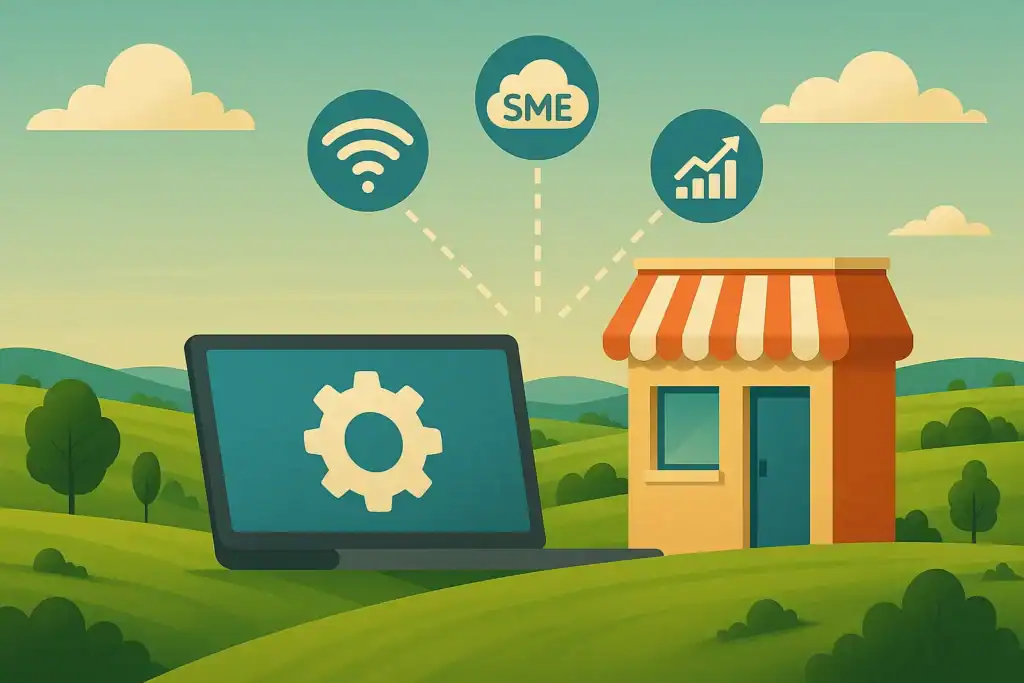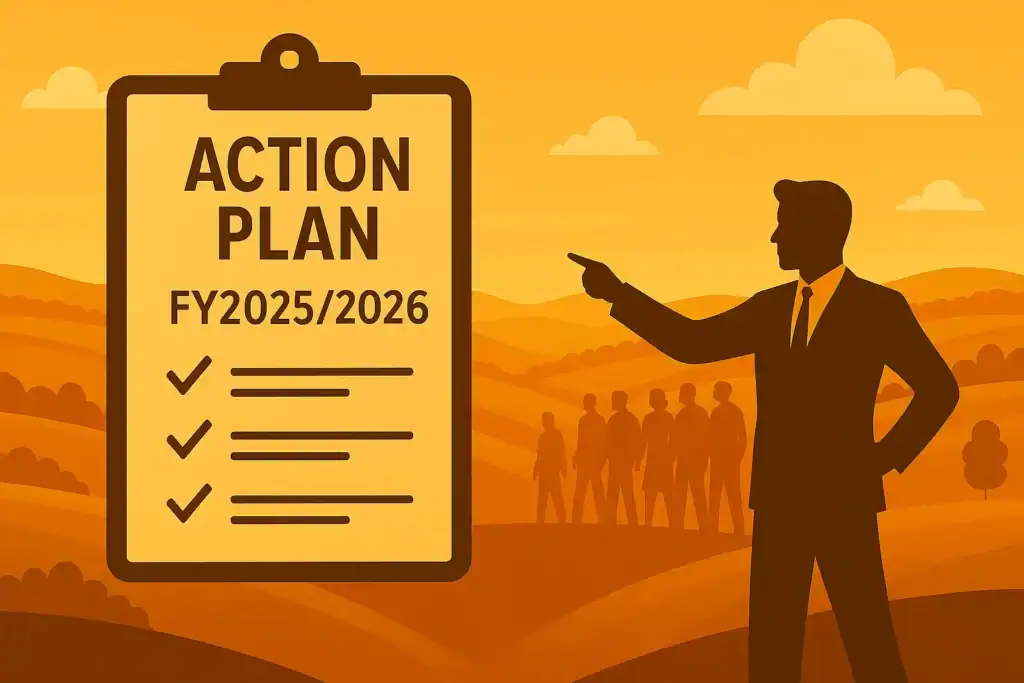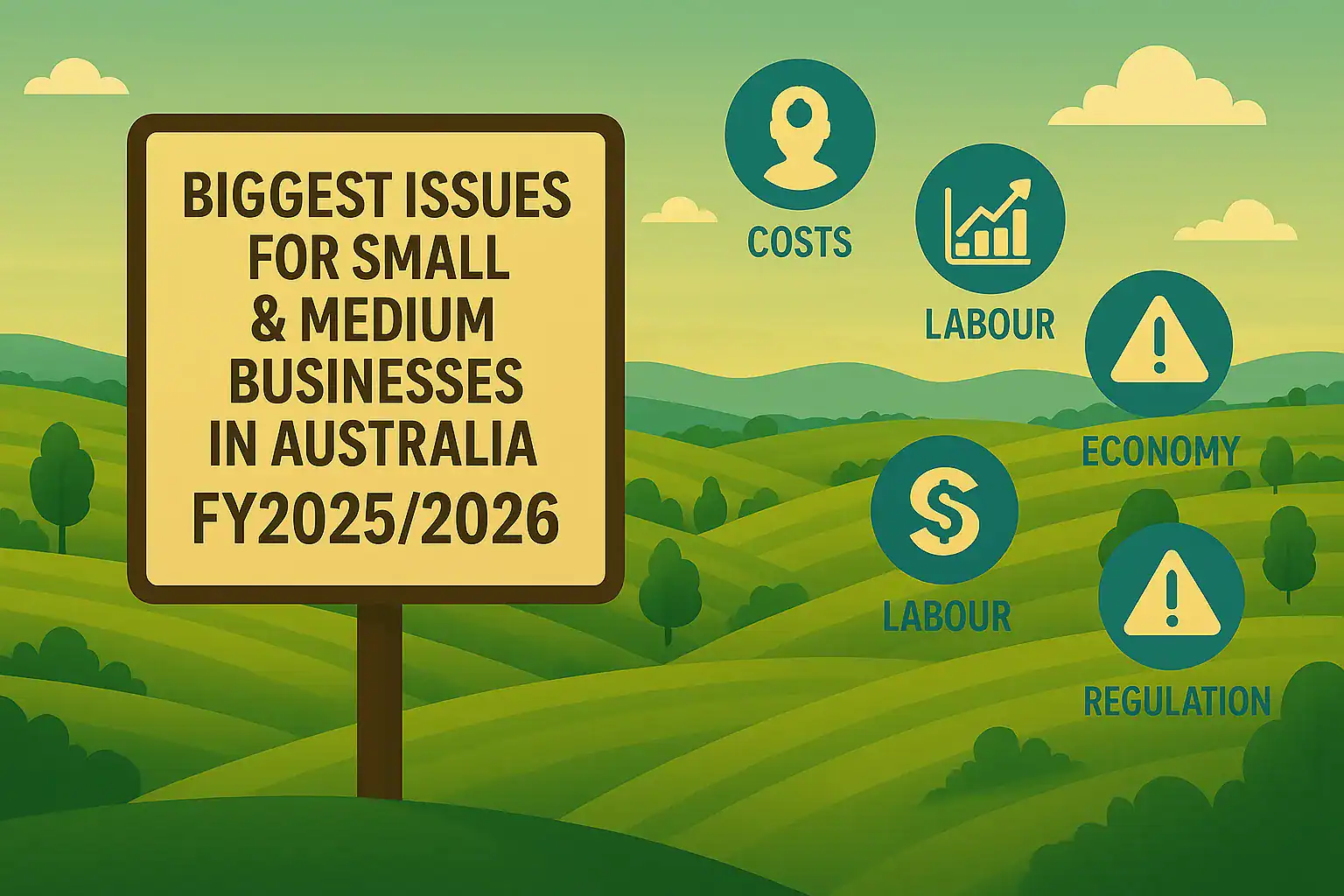The 12% superannuation rate hits on 1 July 2025, and if you’re running one of Australia’s 2.5 million small businesses, you need answers now. This guide breaks down how SMEs in Australia can handle rising costs, tech disruption, and economic uncertainty in FY2025/2026.
We’ll show you:
- How to budget for the super increase without cutting staff
- Which government AI programs actually help small and medium enterprises
- Why successful franchises aren’t expanding (and what it means for your business)
- Practical cash flow solutions when 75% of Australian businesses face late payments
- Real funding options beyond the big four banks
These strategies come from businesses currently surviving and thriving in today’s economy. Let’s get straight to what works.
The Super Contribution Shock: How 12% SG Impacts Your Business Size and Budget
The 12% superannuation guarantee means employers now pay an additional 0.5% on every employee’s ordinary time earnings compared to last financial year. Small businesses with 10 employees earning $60,000 each face $3,000 in extra annual costs, directly reducing profit margins.

Let’s do some back-of-the-napkin math on how this could affect your business.
Breaking Down the Numbers for Small Businesses
We want to show you how this tax could affect small- to medium-sized businesses using some common examples. This will help you get a better feel for the real-world impact on your bottom line.
The impact varies dramatically depending on your business size and annual turnover:
- Micro businesses (1-4 employees): Every dollar counts when you’re this small. A single employee on $70,000 means an extra $350 annually, manageable, but multiply that by four and you’re looking at $1,400 that could’ve been profit
- Small businesses (5-19 employees): The squeeze starts to show. Ten employees averaging $55,000 each? That’s $2,750 gone from your operating expenses
- Medium businesses (20-199 employees): The hit scales up significantly. Fifty employees mean tens of thousands in additional costs
The Australian Bureau of Statistics indicates that three-quarters of SMEs already struggle with cash flow. This super increase is going to make it harder, but don’t worry, there’s hope. We’ve got some proven strategies that SMEs are using to combat this.
Strategies to Manage Increased Super Costs
We’ve spoken to other small-business owners to round up the smartest ways to absorb the 12% super rise without cutting staff or hiking prices. Don’t worry, you won’t have to pass the buck onto your customers. Here are some creative approaches that real SMEs are using to keep their teams engaged and their margins intact:
- Offering rewards packages instead of salaries: Instead of bumping everyone’s salary, offer perks that sit outside the super calculation, such as free car parking spots, a work-from-home tech allowance or paid conference tickets. One Sydney boutique agency switched twelve staff to a perks-based model and carved out $15,000 in savings last year.
- Automate to eliminate drudgery: That inventory-tracking tool you keep postponing? Turn it on now. Shaving even 2% off process times can more than cover your extra super outlay. Professional services firms report that simple scheduling software frees up 5–8 billable hours per person each week, time you can reinvest in client work.
- Tap into every incentive: Even if you’re tweaking a menu in your café, streamlining your workshop floor or building a more efficient booking system, the R&D Tax Incentive could reimburse up to 43.5% of those expenses. Talk to your accountant to make sure you’re claiming every dollar you’re entitled to.
- Think flex-structure: Job-sharing, part-time contracts or staggered shifts can spread your super bill more evenly across the pay cycle. Some retailers find that mixing casual and permanent part-timers lets them scale up for peak periods without a big fixed-cost spike.
Each of these tactics lets you protect your profit margins while still investing in your people. Pick one or two to pilot this quarter, measure the savings, and then roll out what works across the rest of your team.
Payday Super Coming July 2026
The shift to payday super from 1 July 2026 fundamentally changes cash flow management for Australian businesses. Instead of quarterly payments, you’ll pay super with each pay run.
For cash-strapped small and medium enterprises, this means:
- No more using super contributions as a three-month interest-free loan
- Weekly cash flow impacts for businesses paying weekly wages
- System upgrades needed (most payroll software isn’t ready yet)
If you’re a small business, we recommend building a dedicated super buffer today to keep your cash flow steady. Start setting aside extra super each pay cycle in a separate account to have funds ready by July 2026 and avoid a cash flow shock.
Economic Environment Pressures Crushing Australian Business Growth
Right now, small businesses across Australia are getting squeezed by rising prices, sky-high power bills and customers cutting back. Costs have climbed about 15–20 percent, yet sales remain stagnant. No wonder so many owners are focused on just keeping the doors open instead of planning for growth.

And the pinch looks different for everyone: maybe your next electricity bill will knock you sideways, or perhaps your regulars are ordering less. Your first step is to work out which of these pressures is hurting you most, so you can tackle it head-on.
Let’s cover each of these factors in more detail:
Rising Costs
You’re probably already feeling the sting of higher energy bills arriving each quarter. Commercial electricity rates jumped 25% in the past year alone, and it doesn’t look like they’re coming down anytime soon.
Manufacturing and hospitality businesses feel it most (particularly those running cold storage or commercial kitchens 24/7). Small businesses consuming 100 MWh annually now pay an extra $5,000–$8,000 compared to 2023.
But energy is just the beginning of your cost headaches. Beyond electricity bills, inflation touches everything from the supplies you order to the rent you pay. The Reserve Bank’s latest figures show business input costs rising faster than consumer prices, squeezing margins from both ends.
A Melbourne bakery owner recently shared with our team that their flour prices increased 40% while commercial rent rose 15%. If you’re nodding along, just know you’re not alone. Thousands of other business owners are facing the same challenge.
Making matters worse, the money you need to weather this storm has become expensive to borrow. Interest rates sit at levels not seen since 2012, translating to business loan rates of 8-12%.
SMEs who borrowed during COVID-19 to stay afloat now face doubled repayments. One construction company watched their equipment finance jump from $2,000 to $3,500 monthly, wiping out their entire profit margin.
Spending Decline
Another major challenge facing Australian small businesses is consumers are spending less. Retail trade data reveals that discretionary spending dropped 8% year-on-year. You’ve probably noticed that already.
Both B2C and B2B businesses have felt the ripple effects, with spending down across the board.
The knock-on effects might surprise you. Professional services firms tell our advisors that clients now delay projects or request payment plans for work they’d previously approved without question.
Marketing agencies have seen budgets slashed by 30–50% as their clients prioritise survival over growth. Even basic services face unprecedented haggling: a Sydney plumber mentioned customers now get three quotes minimum, instead of accepting the first fair offer.
If your revenue hinges on consumer confidence, things might be tough out there. In hospitality, that means staring at empty tables during what used to be peak service times. Meanwhile, retailers are counting 20–30% fewer shoppers in their centres. And out in regional areas, tourism operators report travellers swapping hotels for camping, leaving once-bustling towns eerily quiet on weekends.
Cash Flow Management
According to recent ASIC data, late payments affect 75% of Australian businesses, with the average payment stretching to 53 days, up from 32 days pre-pandemic. You know how it goes: one customer pays late, so you pay your supplier late, and suddenly everyone’s chasing money.
The old tricks don’t work anymore. Invoice factoring costs more as interest rates rise. Banks tightened their lending just when you need them most, making overdrafts nearly impossible to secure. We’ve seen too many business owners max out personal credit cards or drain their home loan redraws just to make payroll.
Thankfully, new funding options are emerging for businesses like yours. Supply chain finance helps you settle supplier invoices early while giving yourself longer to pay, so you keep goods coming in without draining your bank account. For a payment plan that flexes with your sales, revenue-based financing adjusts repayments to your income, which means you pay less when business slows.
If speed is your priority, peer-to-peer lenders usually approve loans faster than big banks, although you’ll pay a bit more interest for that convenience. Just make sure to explore government programs, too, as many offer low-cost loans or grants specifically aimed at regional businesses and industries under pressure.
Property Market Concerns
Another major pressure you may be noticing is falling property values. If you’re locked into a high-price CBD lease on half-empty offices, that rent eats into cash flow every month.
Look at New Zealand: commercial values there have slipped 15–20% under the same market squeeze, and Australian banks are already reacting by asking for bigger deposits and cutting loan-to-value ratios on commercial loans. That combination can knock a chunk off your business valuation.
However, you don’t have to sit back and watch your overhead balloon. Start by showing your landlord the alternative of vacant premises and renegotiate your terms.
If that won’t fly, sublease any unused space or partner with a complementary business to share costs. And for some, the boldest move is breaking their lease and relocating to a smaller suburban site where rents are lower and foot traffic is on the up. These steps take courage, but they can turn an expensive liability into a more sustainable operation.
Why Successful Franchises Aren’t Expanding in the Current SME Growth Climate
Successful Franchises are not expanding because the risk-to-reward ratio has shifted dramatically. The Franchise Council of Australia reports that 68% of franchisors delayed new territory releases in 2024, and the trend continues into 2025. If established franchise systems with proven business models are scared to grow, what does that tell you about the current market?

We’ve been tracking this trend closely, and the reasons reveal broader challenges facing all SMEs in Australia. When franchises (businesses designed for rapid replication) won’t expand, it signals deep structural problems in our economy that affect every business owner.
The franchise slowdown stems from three key factors: regulatory changes, recruitment challenges, and market conditions. Let’s break down each one and what they mean for your business.
The New Franchising Code Reality
When the revamped Franchising Code came into effect in April 2025, franchisors suddenly had to offer much more detailed financial disclosures and extend cooling-off periods.
Those extra safeguards are great for prospective franchisees, but they’ve also slowed down expansion and sent legal costs soaring. For example, one Melbourne café franchise watched its lawyer’s bill for opening new territories double almost overnight.
In light of these changes, think about how much financial information you’re prepared to share with potential partners and investors up front.
The franchises that are gaining traction right now are the ones leaning into complete transparency. Yes, laying all your cards on the table can stretch out your rollout timeline, but it also builds the kind of trust that leads to stronger, more committed franchisees down the road.
Which Franchises Are Winning vs Losing
Now, we want to cover some of the winners and losers on the market, so you can see which types of companies are thriving. We think seeing these trends will help you make adjustments to your own strategy and meet the challenges ahead.
The biggest losers so far have been discretionary spending businesses like boutique fitness centres, premium food concepts, and entertainment venues. If your small business falls into these categories, you’re facing the same challenges as major franchise networks.
We suggest shifting your focus to necessary services within your industry. Identify the offerings your customers rely on most, then promote them with targeted bundles or limited-time packages. That approach locks in reliable income, even when budgets tighten.
Digital Transformation: The Make-or-Break Factor for Medium Enterprises SMEs
Here’s the uncomfortable truth: if you’re not using technology to solve real problems in your business, you’re probably falling behind. But here’s what’s even more uncomfortable is that most government “digital transformation” programs are designed by people who’ve never run a payroll or worried about cash flow.

The numbers tell a sobering story. Only 35% of SMEs in Australia have adopted any form of AI, while 23% admit they don’t even know how these tools could help their business. Meanwhile, 42% have zero plans to explore automation. You might be thinking this sounds like your competitors, which means there’s still time to gain an advantage.
But the reality of the current market is that the businesses thriving right now are focusing on solving boring problems with simple tools rather than chasing shiny new gadgets.
The AI Adoption Crisis Among SMEs
We find that most Australian companies drastically overcomplicate integrating AI into their processes. It’s actually far simpler than most companies think (and most consultants make it seem).
In our experience, companies either freeze and stubbornly don’t integrate AI at all…or they do the opposite: they shoot for the moon and install overcomplicated, expensive systems that you need a PhD to use.
Don’t be like that. Start small, with some quick wins that anyone can achieve, and then grow from there.
Here’s an example as a warning. A Brisbane accounting firm spent $50,000 on an AI system that promised to automate everything, only to find it couldn’t handle their basic invoicing quirks. See why starting small is better? Six months later, they’re back to spreadsheets and feeling burned.
You know what works better? Start small:
- Automated reporting: Hook up your POS or accounting software such as Square Dashboard, Xero, or QuickBooks, and schedule weekly sales summaries straight to your inbox.
- Customer service shortcuts: Embed a simple chatbot like ManyChat or Tidio on your site to handle “What are your opening hours?” and other FAQs, saving you around 20 interruptions a day.
- Data analysis that helps: Plug your data into Google Looker Studio or Microsoft Power BI to spot which products sell best on rainy days or flag customers who haven’t ordered in 60 days.
The Australian government launched AI Adopt centres across the country, offering free consultations for small and medium enterprises. Sounds great, right? The catch is you need to know what problems you’re trying to solve before walking through their doors.
Government AI Grants and Support Programs for Small Businesses
By late 2025, the National AI Plan will roll out funding aimed at SMEs ready to automate routine tasks. But the catch is that the application process favours businesses that already understand their biggest operational headaches. To make the most of this opportunity, start today by:
- Listing your time sinks: Write down every task that eats into your week, such as reconciling invoices, scheduling appointments or answering the same customer question repeatedly.
- Ranking by pain: Identify which of those tasks frustrates you the most.
- Building your AI roadmap: Use your top pain points to shape a grant proposal that shows exactly how automation will improve your workflow.
Taking these simple steps now will give you a head start and bring you closer to securing government support for your first AI pilot.
The Importance of Cybersecurity for Small Businesses
Here’s where things get scary. Cyber attacks on small businesses jumped 150% in 2024, yet most SMEs spend less on cybersecurity than they do on coffee. One Melbourne construction company lost $45,000 when hackers accessed their banking through a simple email trick.
The good news? Basic protection costs less than your monthly phone bill. All you need to do to prevent 80% of attacks is start using multi-factor authentication, schedule regular backups, and implement some basic employee training. Yes, that’s really it.
Most attacks succeed because businesses skip fundamentals, not because hackers are particularly clever.
And the most ridiculous thing is we’ve overcomplicated cybersecurity when criminals still rely on the same old tricks that worked in 2010.
This digital divide creates opportunities for those willing to move first. But it also highlights the broader challenge all Australian businesses face: finding and keeping good people.
The Talent War: How Small and Medium Enterprises Can Compete
Hiring skilled employees in Australia is NOT easy.
You’re competing against Google for developers, against government departments for accountants, and against mining companies for skilled trades. Welcome to Australia’s talent shortage, where even McDonald’s offers signing bonuses and your local café struggles to find weekend staff.

The numbers paint a grim picture for SMEs. Labour shortages affect 63% of Australian businesses, with professional services and hospitality hit hardest. But here’s what the statistics don’t capture: the hidden costs of constantly training new employees while your experienced ones get poached by competitors offering 20% pay rises.
We’re seeing three main battlegrounds where small businesses either win or lose talented employees: compliance complexity, creative compensation, and workplace culture. Understanding these facts helps you compete even when you can’t match corporate salaries.
Industrial Relations Changes Impact
The Fair Work updates rolling out through 2025 introduce new right-to-disconnect rules, expanded casual conversion rights and tougher workplace flexibility requirements. For many small businesses, that adds another layer of red tape just when you’re already stretched thin.
It’s ironic that laws meant to protect workers can end up squeezing the small businesses that go out of their way to treat staff well. Larger companies with deep pockets absorb those extra costs with ease.
Still, you can turn this to your advantage. Embracing real flexibility often costs less than fighting compliance. For example, letting people work from home slashes your rent, and offering adjustable start times helps parents dodge childcare fees. In fact, one Perth consulting firm cut staff turnover by 40% simply by giving employees the freedom to pick their own hours.
Creative Retention Strategies
Money talks, but it’s not the only conversation your employees care about. The most successful SMEs we work with focus on things large corporations struggle to provide: genuine mentorship, varied responsibilities, and direct access to decision-makers.
Consider these perks instead of offering salary:
- Professional development with purpose: Instead of generic training courses, send employees to industry conferences where they represent your business and build networks
- Equity participation: Profit-sharing or small equity stakes give employees skin in the game without immediate cash outlay
- Life integration: Flexible leave for family events, pet-friendly offices, or sabbatical options after three years
- Career progression planning: Clear pathways showing how roles evolve, even in small teams
How to Build Workplace Culture That Retains High-Quality Employees
Of course, rolling out perks is only half the battle. The best companies build a workplace culture that makes employees want to stay on for years. Your goal should be to build an office where employees want to work.
But you need to do it right. Employees can tell when you’re tossing out freebies just to stop them walking out the door. The businesses winning the talent war are the ones who’ve always treated culture as the backbone of every role and interaction.
That mindset shift, seeing culture as a way of working, not a checklist of perks, changes everything about how you hire, manage and retain your team. And it ties directly into the support systems available for Australian businesses looking to attract and develop the right people.
Government Support: What’s Available for Australian Economic Recovery
The government announces new business support programs almost weekly. If you’re like most SME owners, you’ve probably tried applying for funding only to get lost in a bureaucratic maze or find out you don’t qualify after hours of paperwork. It’s easier than politicians let on. Most programs fall into just three categories that work for your business.

Let’s cut through the noise and focus on what’s genuinely accessible right now, plus the insider knowledge that makes applications successful.
Top Funding and Support Programs for Australian SMEs
Finding your way through the maze of government and state support can feel overwhelming. Here’s a quick rundown of the most valuable programs designed to help your business grow, innovate and secure funding.
Business Growth Service: Launched nationwide in 2024, this program offers free one-on-one coaching for businesses with annual turnover between $1.5 million and $100 million.
Industry-Savvy Coaching: You’re paired with advisors who know your sector inside out. For example, a Gold Coast construction company used its sessions to restructure debt and secure $200,000 in additional working capital.
R&D Tax Incentive: A hidden gem for SMEs. Any systematic approach to solving technical problems qualifies. You don’t need to be building rockets. Hospitality businesses have claimed credits for new cooking processes, retail operations for better inventory systems and professional services firms for client management tools.
Victoria’s Business Growth Grants: Provides up to $50,000 to help you expand into new markets.
Queensland’s Business Development Fund: Offers loans at below-market interest rates.
South Australia’s Export Assistance Program: Supports businesses aiming to reach overseas customers.
Match your needs to the right program: Review each option against your business goals and location to secure the fastest approvals and the most relevant support.
How to Access This Support
Here’s what successful applicants do differently: they frame their requests around job creation and economic impact rather than just asking for money. Government programs exist to stimulate the economy, not solve your personal cash flow problems.
Once you’ve nailed that angle, turn your attention to paperwork. Document everything before you apply. Track how many employees you plan to hire, which suppliers you’ll use, and what equipment you’ll purchase locally. Applications that show clear economic multipliers get approved faster than those focusing solely on business benefits.
The biggest mistake we see? Applying for multiple programs simultaneously without understanding how they interact. Some grants affect your eligibility for others. Some require you to exhaust commercial options first. Getting this wrong can blacklist you from future opportunities.
Most importantly, start building relationships with program managers before you need funding. Attend their webinars, ask questions, and introduce yourself. When application time comes, you’ll have inside knowledge about what evaluators want to see.
The challenge with all these programs is timing them right with your business cycle and cash flow needs. Which brings us to the harsh reality many Australian businesses face when support isn’t enough.
Your Action Plan for FY2025/2026
The brutal truth is that half of the businesses reading this guide won’t exist in their current form by 2027. The other half will emerge stronger, more efficient, and better positioned for the recovery that always follows tough times, based on Reserve Bank of Australia data on SME survival rates during economic downturns.

The difference between survivors and casualties comes down to four immediate actions you can take this week, not next quarter, when it might be too late.
Take Action This Week
Don’t wait until July catches you off guard. These steps will shore up your cash flow, streamline operations and help you lock in funding before budgets run dry.
Step 1: Calculate your superannuation hit and reserve the funds now.
Work out exactly how much the 12% super rate adds to your current payroll and move that amount into a separate account today so you’re not scrambling when July arrives.
Step 2: Audit your manual tasks and invest in automation.
List every process that costs you more than 30 minutes a week. Pick a simple tool (around $200 per month) and you could cut reporting time from 12 hours to 2, covering the software cost within six weeks.
Step 3: Apply for grants and programs before the money runs out.
Check your eligibility for federal and state support and submit applications this week. Many schemes close early once their funding pots are empty.
Step 4: Diversify your customer base to reduce risk.
Calculate what share of your revenue comes from your top three clients. If losing any one of them would leave you exposed, start lining up smaller contracts, exploring new markets or partnering with complementary businesses.
Build Your Support Network
The businesses thriving right now share one trait: they’ve built strong networks before they needed them. Join industry associations, attend local business events, and connect with other owners facing similar challenges. When problems arise, you’ll have experienced advisors rather than Google searches.
Consider peer mentoring groups where business owners meet monthly to share challenges and solutions. For businesses facing challenges beyond these solutions, sometimes the most responsible choice is to plan an orderly exit.
Our comprehensive business closure guide provides step-by-step instructions for winding down operations while protecting your personal assets and maintaining professional relationships.
Frequently Asked Questions About SMEs in Australia
Running a small or medium enterprise comes with unique challenges and opportunities. These frequently asked questions address the most common concerns Australian business owners have about SME definitions, market conditions, and growth strategies in the current economic environment.
What is considered an SME in Australia?
The Australian Bureau of Statistics defines SMEs as businesses with fewer than 200 employees. However, the Australian Taxation Office uses annual turnover to classify small businesses as those earning less than $10 million yearly. Most SMEs fall into three categories: micro businesses (0-4 employees), small businesses (5-19 employees), and medium enterprises (20-199 employees). Your classification affects eligibility for government support programs and tax concessions.
How many SME businesses are there in Australia?
As of June 2024, there are approximately 2.66 million actively trading businesses in Australia, with 97.2% classified as small businesses employing fewer than 20 people. SMEs collectively employ over 5.1 million Australians and contribute around one-third of the country’s gross value added. This makes them the backbone of Australia’s economy, particularly in regional areas where they often provide services larger companies won’t offer.
What are the four types of SMEs?
Australian SMEs typically operate as four main business structures: sole traders (individuals trading under their own name), partnerships (two or more people sharing profits and responsibilities), companies (separate legal entities with shareholders), and trusts (structures holding assets for beneficiaries). Each structure has different tax implications, liability protections, and regulatory requirements. Most small businesses start as sole traders before incorporating as companies when they grow.
What is the SME outlook for Australia?
The SME outlook for FY2025/2026 remains challenging but manageable. Rising costs, including the 12% superannuation rate and increased energy prices, create pressure on profit margins. However, government support programs, improving digital adoption, and recovering consumer confidence provide opportunities for growth. Businesses focusing on necessary services, embracing technology, and maintaining strong cash flow management are best positioned to thrive.
What is the growth of small and medium enterprises?
SME growth has been uneven across sectors. While total business numbers increased by 1.3% in 2023-24, many established businesses are consolidating rather than expanding. Professional services and healthcare show steady growth, while retail trade and hospitality face headwinds from reduced discretionary spending. The key growth driver is productivity improvements through technology adoption rather than simple expansion.
What is the meaning of small to medium-sized enterprises?
Small to medium-sized enterprises represent independent businesses that are privately owned, managed by individuals or small teams, and operate below the threshold of large corporations. They’re characterised by greater flexibility, closer customer relationships, and faster decision-making compared to large businesses. SMEs often specialise in niche markets or provide personalised services that larger companies can’t efficiently deliver.
What is a small to medium enterprise in Australia?
In Australia, a small to medium enterprise is any business operating independently with fewer than 200 employees and an annual turnover typically under $100 million. These businesses span every industry from construction and professional services to retail and manufacturing. They’re often family-owned or operated by entrepreneur-founders who maintain direct involvement in daily operations and customer service.
What are the success factors of small and medium-sized enterprises?
Successful SMEs share common characteristics: strong cash flow management, adaptability to market changes, investment in employee development, and focus on customer satisfaction. They typically maintain lean operations, leverage technology for efficiency, and build strong local networks. The most resilient SMEs diversify their revenue streams, plan for economic cycles, and maintain adequate financial reserves for unexpected challenges.
What is the trend in SME lending?
SME lending has tightened significantly since 2022, with interest rates rising 365 basis points for new loans. Banks now require stronger security and cash flow evidence before approving funding. However, alternative lenders, peer-to-peer platforms, and government-backed schemes provide new options. The trend is toward more sophisticated lending criteria based on real-time business performance rather than traditional security-based assessments.
What are SME markets?
SME markets refer to the economic sectors where small and medium enterprises operate competitively. These include professional services (accounting, legal, consulting), construction and trades, retail trade, hospitality, healthcare, and technology services.
SME markets are characterised by lower barriers to entry, intense local competition, and the ability to provide personalised service that larger companies struggle to match. Success depends on understanding local customer needs and building strong community relationships.
Surviving and Thriving in Australia’s Economic Storm
Australian SMEs have survived recessions, droughts, floods, and a global pandemic. The current challenges feel overwhelming because they’re happening simultaneously, but they’re not insurmountable. The businesses that thrive will be those that adapt quickly, support their communities, and remember that economic cycles eventually turn.
Your business provides income, employment for your team, services for your customers, and economic activity for your community. Every day you keep operating, you’re contributing to Australia’s recovery.
The strategies in this guide are effective because they’re based on real businesses that have survived real challenges. Take what fits your situation, adapt what doesn’t, and remember that seeking help shows strength, not weakness.
Ready to take action? Visit abmag.com.au for more resources, tools, and support designed specifically for Australian business owners like you.

